


ORGANS OF PARIS © 2024 Vincent Hildebrandt HOME ALL ORGANS

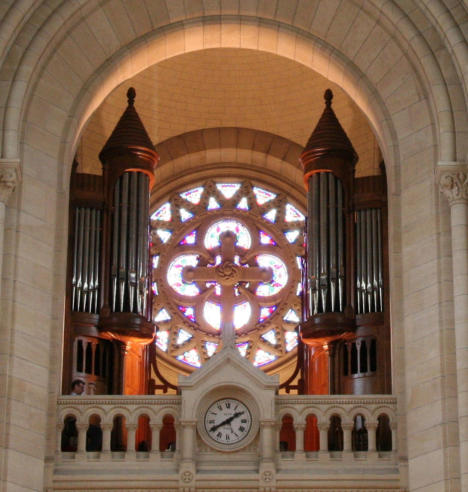

This big and very majestically positioned church was
built in during the reign of Napoleon III, by the
architect Louis-Antoine Heret, in a neo-roman style
with gothic elements and a modern metallic structure.
It is built on the steep slope of the Hill of
Ménilmontant, which necessitated the construction of
a 54 steps to make up for the difference in level
between the facade and the apse. It is the third Church
in Paris by its length and has a very large surface of
slate roofs. They are supported by wooden frames, but
the attic of the Church also have metal beams
supplementing cast-iron ribs visible under the vaults
of the nave. It was the first church in Paris to have a
visible metal structure.

C1
The organ of Notre-Dame-de-la-Croix is one of the rare
organs built by Cavaillé-Coll, which have not been altered
to a significant extent during the past centuries. The organ
was built in 1872-1874.
When designing the instrument, Cavaillé-Coll faced two
serious problems: the rose window, and a bell passageway
in the center of the gallery. It was used for the mechanical
operation of the bells and as a route to bring down the
bells for repairs. From the floor to the steeple, there are
nine crosses in the rose window, a symbolic number, and
none of them had to be concealed. So Cavaillé-Coll built an
organcase in two sections leaving the center of the gallery
and the rose window unmasked. The passageway for the
bells prevented building a console in the center of the
gallery with a direct action towards both organcases.
The original plan included a Récit expressiv, a Grand-
Orgue, a Positif expressiv and a Pedal. The console was
installed, facing the nave, with its three manuals. After the
installation of the Récit and Grand-Orgue, it became
evident that it would be impossible to build the action for
the Positif. So the first manual, that was to be the Positif,
was transformed into a permanent coupling manual,
meaning that it couples the Récit with the Grand-Orgue. To
take into account the passageway for the bells, Cavaillé-
Coll was forced to turn the console (facing the rose
window) and to use a complex action design, which
resulted in an action which is very hard for the organist
(although a Barkermachine is assisting the action of the
GO).
The right organcase houses pipework from the Grand-
Orgue division. The action, part of the wind system and the
Barker machine are located in the lower part of the
organcase. The left organcase houses pipework from the
Recit. Just next to it, there is a large empty space, meant for
the 11 stops of the never built Positif and now occupied by
a electric motor. The Pedal division is located on each side
in the back of the gallery with in the middle the main
bellows.
1912
Charles Mutin renovated the organ and raised the wind
pressure.
1922
Overhaul by Fernand Prince.
1955
Erwin Müller modified two stops: the 4' Octave in the
Grand-Orgue became a 2 2/3' Quinte; the harmonic
progression of the Plein Jeu III-VI in the Grand-Orgue was
modified to become a Plein-Jeu III-IV with breaks (C = 1 1/3,
c = 2, c' = 2 2/3', c'' = 4).
1989, the organ was restored by Daniel Birouste (Plaisance)
with a limited financial budget.
2010
Overhaul by Hubert Brayé. An important work of
equalization, especially concerning the reed stops, was
carried out.
Although this organ has only 26 stops, the instrument has an
amazing power and it can be described as one of the finest
Cavaillé-Colls in Paris.
Site of the organ
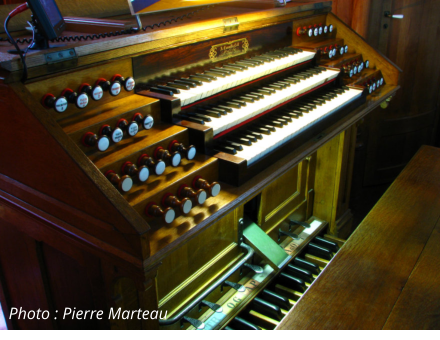
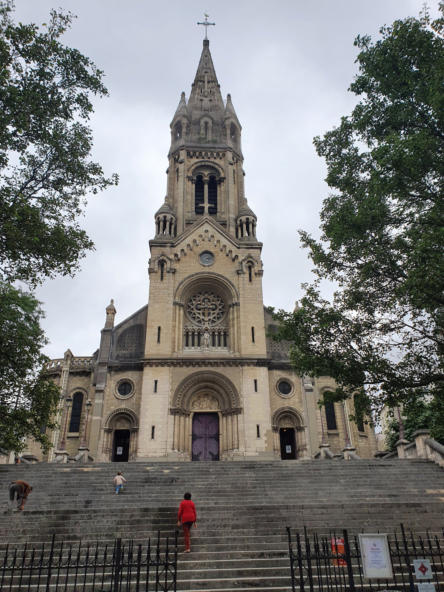
Photo : Christopher Marx
1874 - Cavaille-Coll (1)
1912 - Charles Mutin (6)
1922 - Fernand Prince (6)
1955 - Erwin Muller (3b)
1990 - Daniel Birouste (5)
2010 - Hubert Brayé (6)
III/26 - traction mécanique -
composition
Organiste titulaire
Frédéric Denis
Fanmous organists in the past:
Gaston Litaize (1930-1932), Jean Langlais (1932-1934)
Concerts
Seldom
Masses with organ
Saturday 6 PM, Sunday 11 AM, 18 PM
Videos
Frédéric Denis
Audio
•
Frédéric Denis (grand orgue), Eliane Stefan
(orgue de choeur) - Grand choeur dialogué -
Eugène Gigout
•
Frédéric Denis (grand orgue) - Carillon de
Westminster - Louis Vierne
photo GO: Jeroen de Haan
Organs of Paris
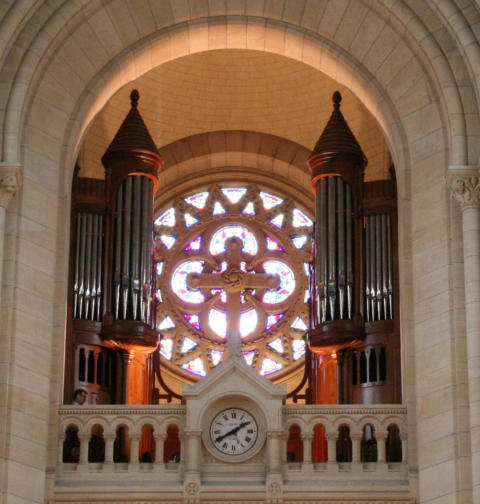
ORGANS OF PARIS © 2024 Vincent Hildebrandt ALL ORGANS
C1
The organ of Notre-Dame-de-la-Croix is one of the rare
organs built by Cavaillé-Coll, which have not been altered to a
significant extent during the past centuries. The organ was
built in 1872-1874.
When designing the instrument, Cavaillé-Coll faced two
serious problems: the rose window, and a bell passageway in
the center of the gallery. It was used for the mechanical
operation of the bells and as a route to bring down the bells
for repairs. From the floor to the steeple, there are nine
crosses in the rose window, a symbolic number, and none of
them had to be concealed. So Cavaillé-Coll built an organcase
in two sections leaving the center of the gallery and the rose
window unmasked. The passageway for the bells prevented
building a console in the center of the gallery with a direct
action towards both organcases.
The original plan included a Récit expressiv, a Grand-Orgue, a
Positif expressiv and a Pedal. The console was installed,
facing the nave, with its three manuals. After the installation
of the Récit and Grand-Orgue, it became evident that it would
be impossible to build the action for the Positif. So the first
manual, that was to be the Positif, was transformed into a
permanent coupling manual, meaning that it couples the
Récit with the Grand-Orgue. To take into account the
passageway for the bells, Cavaillé-Coll was forced to turn the
console (facing the rose window) and to use a complex action
design, which resulted in an action which is very hard for the
organist (although a Barkermachine is assisting the action of
the GO).
The right organcase houses pipework from the Grand-Orgue
division. The action, part of the wind system and the Barker
machine are located in the lower part of the organcase. The
left organcase houses pipework from the Recit. Just next to it,
there is a large empty space, meant for the 11 stops of the
never built Positif and now occupied by a electric motor. The
Pedal division is located on each side in the back of the
gallery with in the middle the main bellows.
1912
Charles Mutin renovated the organ and raised the wind
pressure.
1922
Overhaul by Fernand Prince.
1955
Erwin Müller modified two stops: the 4' Octave in the Grand-
Orgue became a 2 2/3' Quinte; the harmonic progression of
the Plein Jeu III-VI in the Grand-Orgue was modified to
become a Plein-Jeu III-IV with breaks (C = 1 1/3, c = 2, c' = 2
2/3', c'' = 4).
1989, the organ was restored by Daniel Birouste (Plaisance)
with a limited financial budget.
2010
Overhaul by Hubert Brayé. An important work of
equalization, especially concerning the reed stops, was
carried out.
Although this organ has only 26 stops, the instrument has an
amazing power and it can be described as one of the finest
Cavaillé-Colls in Paris.
Site of the organ
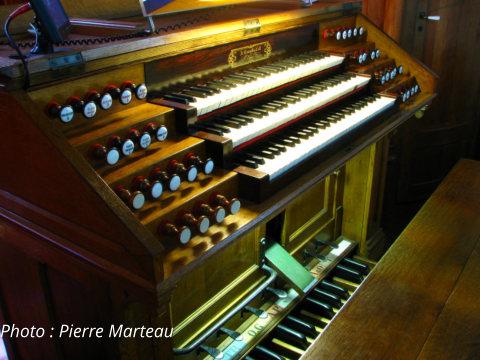
Organiste titulaire
Frédéric Denis
Fanmous organists in the past:
Gaston Litaize (1930-1932), Jean Langlais (1932-1934)
Concerts
Seldom
Masses with organ
Saturday 6 PM, Sunday 11 AM, 18 PM
Videos
Frédéric Denis
Audio
•
Frédéric Denis (grand orgue), Eliane Stefan (orgue de
choeur) - Grand choeur dialogué - Eugène Gigout
•
Frédéric Denis (grand orgue) - Carillon de Westminster -
Louis Vierne
photo GO: Jeroen de Haan
1874 - Cavaille-Coll (1)
1912 - Charles Mutin (6)
1922 - Fernand Prince (6)
1955 - Erwin Muller (3b)
1990 - Daniel Birouste (5)
2010 - Hubert Brayé (6)





















